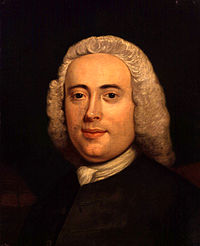
Back جون كانتون Arabic جون كانتون ARZ جان کانتون AZB John Canton Catalan John Canton German John Canton Spanish جان کانتون Persian John Canton French John Canton Hungarian John Canton Italian
John Canton | |
|---|---|
 John Canton | |
| Born | 31 July 1718 Stroud, Gloucestershire, England |
| Died | 22 March 1772 (aged 53) |
| Citizenship | British |
| Known for | Electrostatic induction Pith-ball electroscope Artificial magnets Compressibility of liquids Canton’s phosphorus |
| Awards | Copley Medal (1751), (1764) |
| Scientific career | |
| Fields | Physics |
John Canton FRS (31 July 1718 – 22 March 1772) was a British physicist. He was born in Middle Street Stroud, Gloucestershire, to a weaver, John Canton (b. 1687) and Esther (née Davis). As a schoolboy, he became the first person to determine the latitude of Stroud, while making a sundial.[2] The sundial caught the attention of many, including Dr Henry Miles, a Stroud-born Fellow of the Royal Society. Miles encouraged Canton to leave Gloucestershire to become a trainee teacher for Samuel Watkins, the headmaster of a Nonconformist school in Spital Square, London, with whom he ultimately entered into partnership.

In 1750 he read a paper before the Royal Society on a method of making artificial magnets, and was subsequently elected a Fellow of the society (FRS). In 1751 he was a recipient of the Copley Medal "On account of his communicating to the Society, and exhibiting before them, his curious method of making Artificial Magnets without the use of Natural ones." He was the first in England to verify Benjamin Franklin's hypothesis of the identity of lightning and electricity, and he made several important electrical discoveries.[3]
In 1762 and 1764 he published experiments in refutation of the decision of the Florentine Academy, at that time generally accepted, that water is incompressible.[4][5] In 1768 he described the preparation, by calcining oyster-shell with sulphur, of the phosphorescent material known as Canton's phosphorus.[6] His investigations were carried on while he worked as a school teacher. He died in London aged 53 of dropsy.[3]
He was the recipient of letters that formed the foundation for modern day Bayes' Theorem from Thomas Bayes, which were then published by the Royal Society. John Canton did not receive those letter directly from Bayes, but through an intermediary after the death of Thomas Bayes. Richard Price initially established the communication between Thomas Bayes and John Canton.[7]
Canton is now mainly remembered for his work in electrostatics,[2] particularly the invention of the pith ball electroscope, and his studies in atmospheric electricity.[8] He is honoured with a blue plaque at the site of his old school in his hometown of Stroud.[9]
- ^ "John Canton | British physicist". Encyclopedia Britannica.
- ^ a b Herbert, K B H (March 1998). "John Canton FRS (1718-72)". Physics Education. 33 (2): 126–131. doi:10.1088/0031-9120/33/2/019. ISSN 0031-9120. S2CID 250825856.
- ^ a b One or more of the preceding sentences incorporates text from a publication now in the public domain: Chisholm, Hugh, ed. (1911). "Canton, John". Encyclopædia Britannica. Vol. 5 (11th ed.). Cambridge University Press. p. 218.
- ^ Canton, John (1761–1762). "Experiments to Prove That Water is Not Incompressible". Philosophical Transactions. 52: 640–643. doi:10.1098/rstl.1761.0105. JSTOR 105681.
- ^ Canton, John (1764). "Experiments and Observations on the Compressibility of Water and Some Other Fluids". Philosophical Transactions. 54: 261–262. doi:10.1098/rstl.1764.0045. JSTOR 105560.
- ^ Canton, John (1768). "An Easy Method of Making a Phosphorus, That Will Imbibe and Emit Light, like the Bolognian Stone". Philosophical Transactions. 58: 337–344. doi:10.1098/rstl.1768.0045. JSTOR 105793.
- ^ Bayes, Thomas & Price, Richard (1763). "An Essay towards solving a Problem in the Doctrine of Chance. By the late Rev. Mr. Bayes, communicated by Mr. Price, in a letter to John Canton, A. M. F. R. S." Philosophical Transactions of the Royal Society of London. 53: 370–418. doi:10.1098/rstl.1763.0053.
- ^ Herbert, K. B. H. (1997). "John Canton — Pioneer investigator of atmospheric electricity". Weather. 52 (9): 286–290. Bibcode:1997Wthr...52..286H. doi:10.1002/j.1477-8696.1997.tb06326.x. ISSN 1477-8696. S2CID 122781999.
- ^ "Canton – John | Stroud Local History Society". Retrieved 6 February 2022.